There’s nothing quite as warming as a wood stove or fireplace on the homestead. It’s a nice and easy way to heat your home and you won’t have to worry about the cost of electricity to keep your home warm during the colder winter months.
However, wood heat doesn’t come without a bit of work and effort. You’re going to have to fell the trees or buy your wood, and since you’re on a homestead, it only makes sense to fell the trees on your property and cut the wood yourself.
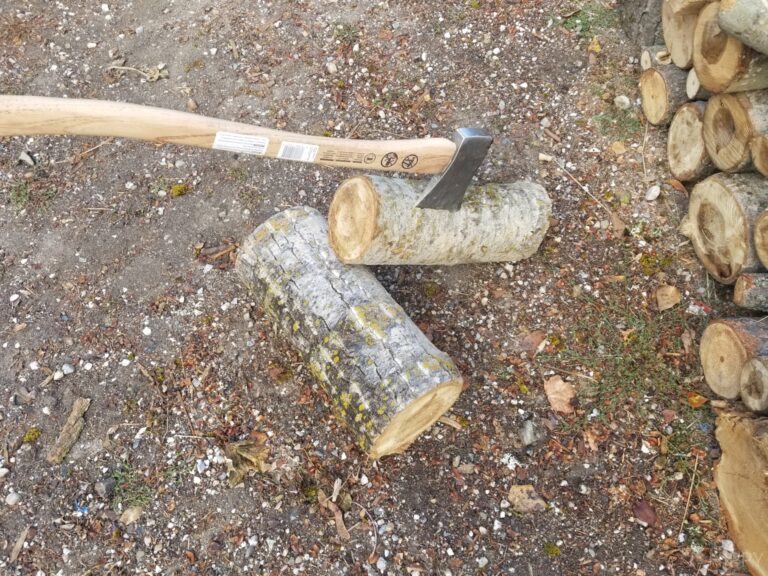
If you rely on wood heat for the winter, you’re going to have to split some wood to fit your fireplace or wood stove.
Splitting wood doesn’t just make the wood fit your fireplace or wood stove easier, it also helps the wood to burn more efficiently which makes for a better fire to keep the house warm.
Splitting wood isn’t as easy as it may appear. You’re going to have to make sure that you’re following some safety tips and that you have the proper equipment in order to safely split your firewood with an ax or a splitting maul. Using the proper equipment will make it easier and safer to get the job done.
You’ll need a good supply of wood, and the required equipment as well as some time to split your wood. Take your time and don’t plan on doing this as an all day long project, you’ll hurt in more places than you ever knew you had if you do this all day long.
We try to plan for an hour or so per day to do this and do it on a daily basis.
Some days we seem to get into a great rhythm and get more done than others but I think it’s probably the type of wood we’re doing that particular day (or perhaps that it’s not me doing it that particular day).
This is how we split the wood for our wood stove on our homestead safely…
Equipment
Safety Gear
Before you begin, you need to acquaint yourself with the proper safety gear. While it may seem overkill, you’ll really appreciate each of the safety gear items at some point in your process of splitting wood.
The goggles will protect your eyes from splinters and dust. The work boots will protect your feet and toes and the gloves will prevent splinters in your hands.
I have long hair so I always pull it back or clip it up, it can get in the way and that could be dangerous. The jewelry and long sleeves should go without saying.
When you visit a link in this article that takes you to a different website where you can purchase something, I may earn a commission. Read my full disclosure for more details.
- Goggles / safety glasses
- Sturdy work boots
- Gloves
- Tie longer hair back
- No loose jewelry
- Avoid wearing loose clothing (long sleeves that don’t have the cuffs buttoned etc.)
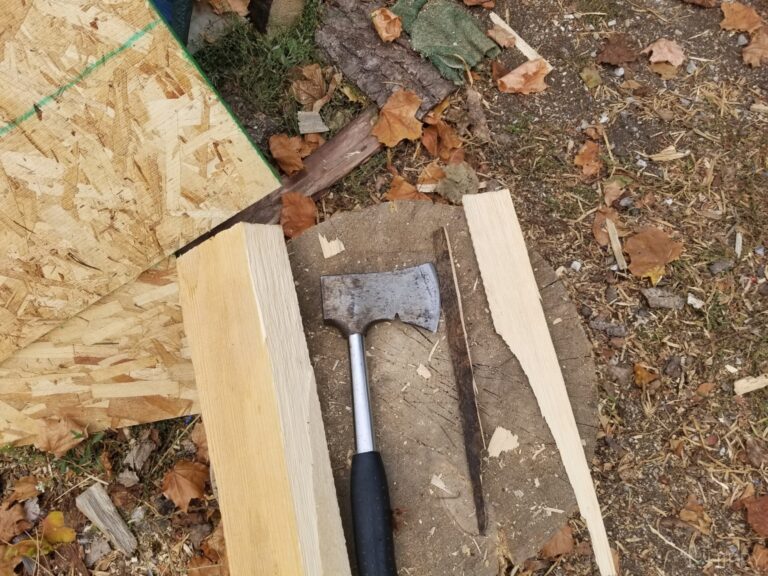
Hatchet
While you’re not going to be using the hatchet to split your wood, you will be using it to split some kindling so we’ve included a bit on the hatchet here. Your hatchet should be sharp and it should be easy to use.
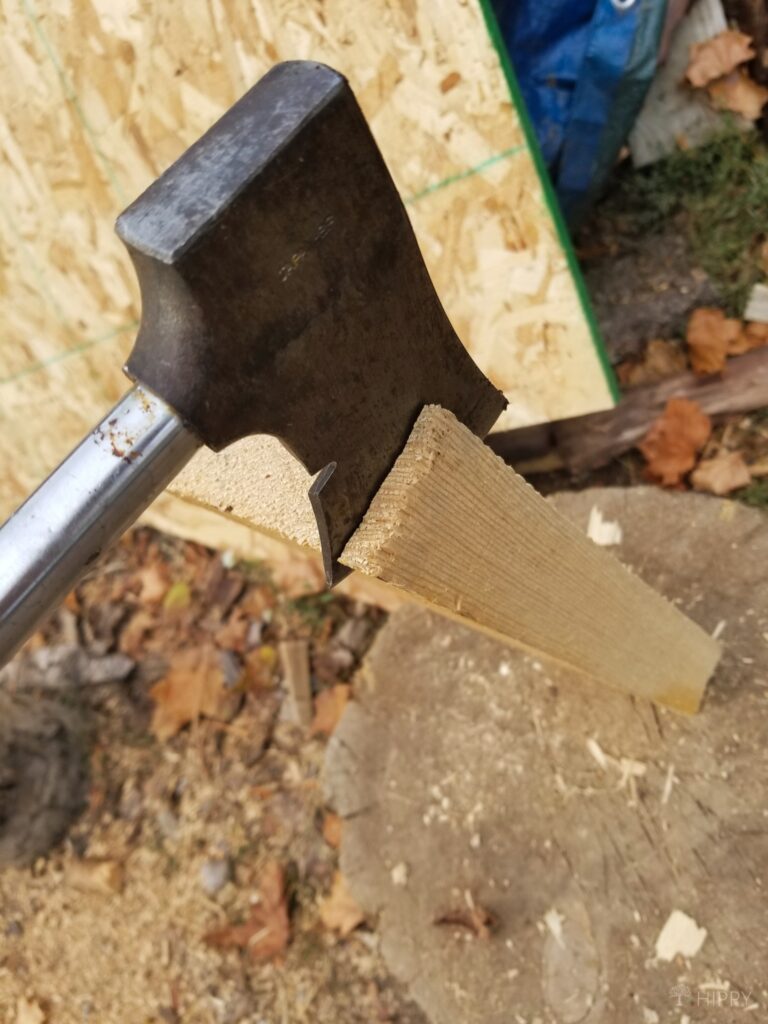
You can use it to “chip” off some kindling on a piece of split wood. Personally, this is my favorite task, I’d rather leave the splitting to the guys, but I also have split my share of wood, just to be fair.
I keep the hatchet sharp with a metal file or a whetstone and make sure that I sharpen it often when I’m splitting kindling with it.
Ax
There are two main characteristics of a good ax. The first is that the blade is sharp. You can keep it sharp with a metal file or grinder or even a whetstone. Take the time to sharpen your ax as required to avoid doing any damage to the head of your ax.
Depending on what you’re doing, you may need to sharpen the blade of your ax a few times while you’re splitting wood. The other important consideration is the blade should be fairly thin.
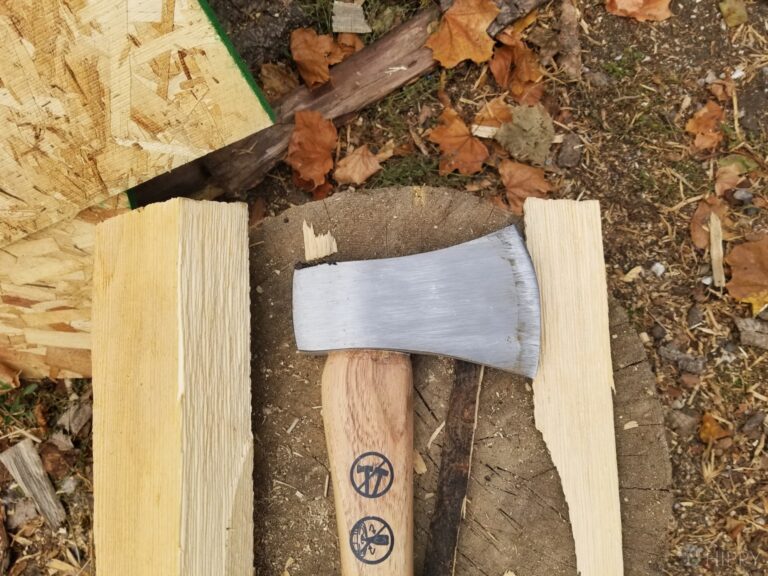
I’ll also mention that there are different handle lengths. We have chosen a medium sized length handle for us as I am shorter and prefer it over a very long handle that makes it seem more like a walking stick to me.
An ax will come in varying sizes. The easiest way to determine the right size for you and your needs is to go down to the local hardware store and try out several different sizes.
Life the ax up and feel the weight of it. Get an idea of how long your reach is and how easy it is to maneuver the ax for your needs.
We prefer a 2 and ¼ inch ax that has a wooden handle. The handle is slightly curved and we like that as it gives it somewhat of an ergonomic appearance and feel.
Ax handles come in both fiberglass and wood. Many prefer a fiberglass handle as they believe that it’s stronger. It’s up to the individual user.
A good ax is used to cut across the wood fibers when you swing it down over the wood. The sharp blade will slice into the wood and separate the fibers. You will interchange your tools periodically while splitting wood. You’ll alternate between your ax, and your splitting maul.
For the most part, you’ll be using your splitting maul to split wood. You may occasionally use your ax.
However, beware that there are times that the ax head is going to get stuck in the wood (particularly if it has knots). So stuck that you may even contemplate throwing the entire piece of wood, ax imbedded in it, into your fireplace or wood stove to get it out.
Take heart, if you gently wobble it back and forth or use your splitting maul on the top part of the ax, you can usually get it out of the wood.
You can also raise the ax overhead (imbedded in the wood) and slam it down on the cutting block to release it on occasion as well. Everyone has this happen now and again so don’t get too frustrated when it happens. It’s going to happen; it’s just the way it goes.
If this does happen, you may need to sharpen your ax again once you get it out of the wood. If someone is laughing at you when this happens to you, be patient, it will happen to them eventually as well and then you can take a turn laughing.
Splitting Maul
Now that we’ve gone over the ax, let’s talk about splitting mauls. Just as with the ax you’ll want to try it out for weight. When we moved to our homestead there was a splitting maul was already out in the woodshed so we didn’t bother to buy a new one.
However, it’s very very heavy in comparison to our ax and there are simply times we use the ax and if that doesn’t work we turn to the splitting maul. Every good homestead should have both an ax and a splitting maul on them so you’ll want to have both anyway.
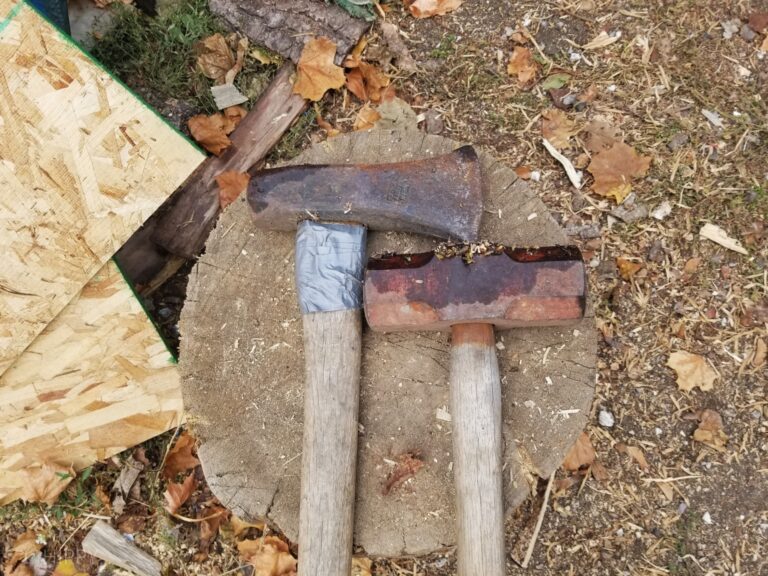
For best results, use the lightest weight splitting maul possible so that you can get the most swing velocity to hit and break apart your piece of wood.
We like a six pound maul but as we said earlier, we’re using the maul that was here when we moved in and it’s about a ten pound maul. It works, but it’s a bit tiring for us and a new, lighter weight, splitting maul is definitely on my list of things to buy for the homestead.
Just as with the ax, if you’re looking to buy a splitting maul, go down to your local hardware store and try out a few different styles.
A good splitting maul is blunt on the end and fatter than an ax. This is because it’s cleverly designed to split the wood piece and break it apart with the blunt force that you use when you swing it.
With practice you’ll get better and better at learning where to split the wood on any given piece of wood. Taking the time to learn where the wood is the weakest and striking on that particular point of the piece of wood is the key to being able to split the wood effectively.
Properly Splitting Wood
It’s important to remember that splitting wood is more technique than brawn. Once you get the right technique down you’re going to find that it’s really very easy to split wood with minimal effort.
You don’t have to be big and burly, you just have to find the weakest part of the piece of wood that you want to split and give it a good hard whack with your ax or splitting maul to effectively get that piece of wood to break apart.
Always take the time to look over your piece of wood and make sure that there aren’t any nails or other metal debris in the wood. Sometimes someone will use a bit of wire to hold a tree up and the wire will grow up into the tree.
Nails and such wire can do some serious damage to your ax or your splitting maul so make sure that you take a quick look over the wood to see that there isn’t anything that could damage your ax or your splitting maul.
Nails and wire in wood that you’re splitting can also fragment and fly into your eye, or injure your leg or arm as well so make sure that you check the wood over carefully and that you’re wearing the proper safety gear. This will be the best way to protect yourself from such potential dangers.
Take the time to look the piece of wood over for any signs of weakness or cracks before you place it on a cutting block.
This is where you’ll want to hit it with the maul as it already has a weak area that may make it split apart easier. With practice, you’ll begin to notice this area with less effort.
To properly split the wood you’ll want to stand slightly above or uphill from the piece of wood. This way you’ll gain more velocity on your swing.
Place your wood on the cutting block (we have two methods we use depending on the piece of wood). Make sure that the weakest area of the wood is set so that you can easily get to the weak area with your ax or maul.
Be sure of your footing before you swing your ax or splitting maul. You want to stand with your legs slightly apart and make sure that you’re not on something that will make you slip or fall. You’ll want a firm footing before you begin swinging your ax or splitting maul.
Make sure that you’re standing far enough away from the chopping block that you’re not going to miss the piece of wood that you’re splitting.
You may want to take a couple of practice swings first to test your aim, distance and warm up your muscles so that you can use a high velocity swing to break the piece of wood apart when splitting it.
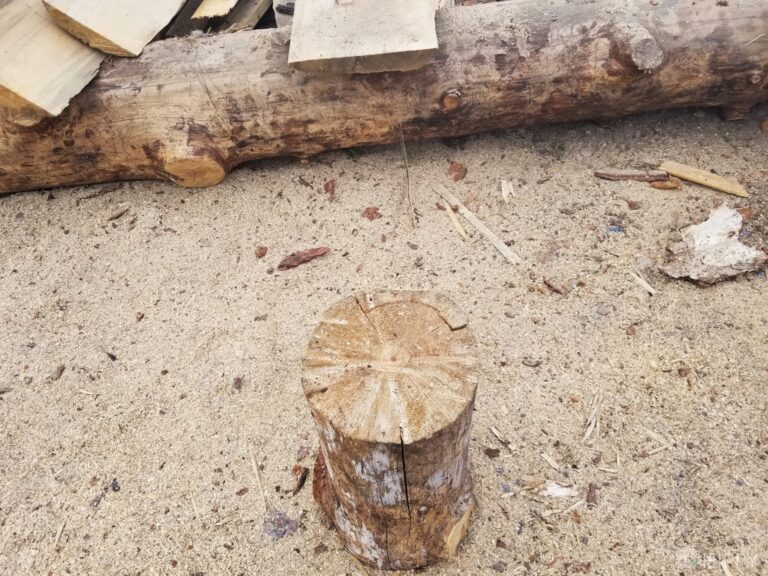
On our homestead we’re always looking for tips and tricks to make things easier. A friend of ours showed us this sideways cutting trick and we decided to try it. It works on some of the wood and on others it seems more frustrating.
We’ve included it because it may work better for you with some pieces of wood. It never hurts to try something new and see if it will work for you. In theory, it really does make sense to hit the side of the wood instead of an intact end.
We did, however, notice that if the piece of wood we’re splitting has a really rounded edge, it can tend to roll away which, if you’re not anticipating this, can cause an injury or you may miss the piece entirely and hit the piece of wood you’re laying it across. Use this technique with caution and keep safety in mind at all times.
Keep in mind that hitting the piece of wood dead center isn’t always the most effective way to split your piece of wood. Sometimes it’s easier if you hit an edge or just slightly off center. The wood is weaker in these areas and much more likely to split.
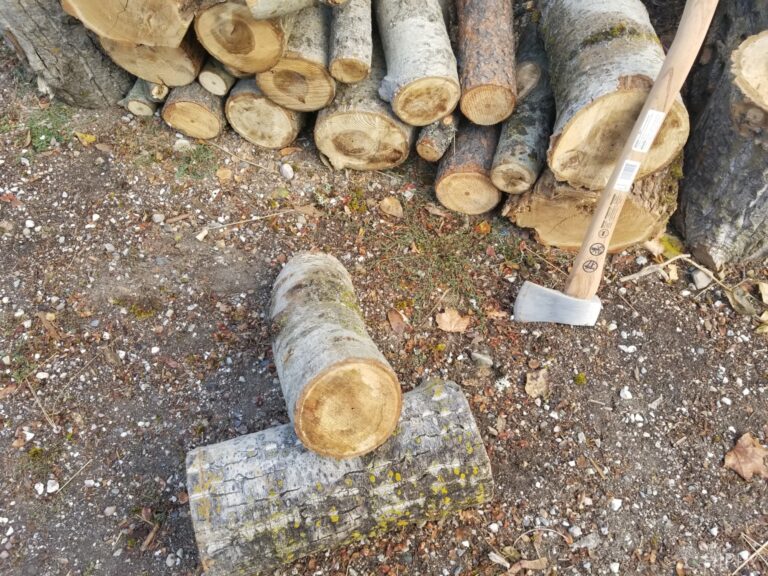
Raise the splitting maul over the top of your head and slightly bend your knees and bend at your waist. Now, picture that piece of wood splitting and swing that maul. Really, it works. You’ll get rid of any aggression and split your wood at the same time.
Keep your eye on the piece of wood you’re striking the entire time. This will help you to focus and make sure that you’re hitting it accurately each and every time.
Repeat as required until the log splits into the right size for your needs.
Sledge Hammer A Wedge
There are some thicker or more challenging pieces of wood that simply won’t fit into your wood stove or fireplace without being split yet these are far too challenging for your splitting maul. For these pieces you may need a sledge hammer and a wedge.
You’ll have to tap the wedge into the wood at the weakest point and then use the sledge hammer to slam it into the piece of wood the rest of the way.
This will eventually break it apart. At this point, you may be able to finish the task with your splitting maul.
We rarely have to use this method on our homestead and in fact, we don’t even own a wedge. We do, however, keep the smaller sledge hammer with our splitting maul and if this happens we will use the sledge to work the splitting maul into the piece of wood.
Many object that using the sledge on the splitting maul could cause sparks, but since we rarely do it we don’t stress over it.
What If You Don’t Have An Ax Or Splitting Maul?
Take heart, there are still some great ways to split wood if you don’t happen to have an ax or a splitting maul on hand. Here are some tried and tested methods that will work if you’re not in possession of an ax or a splitting maul.
Knife With Fixed Blade
If you happen to have a good knife with a fixed blade you can sometimes use this on softer woods. You’ll want to score the wood (you can use a manual saw for this if you happen to have one otherwise you can use the knife).
The blade is usually thicker nearer to the handle so make sure that you’re using it where the blade is thicker so as to avoid breaking your knife.
Hand Saw
If you have a hand saw handy you can use that to split your wood by simply sawing back and forth through the piece of wood.
Manual Chain Saw
This type of chain saw looks similar to a bicycle chain except that the chain part is actually a saw. It’s small enough to keep in your pocket but strong enough to get the job done. It has a handle at either end that is made of paracord, tough nylon or another type of material.
You can either wrap it around a tree trunk or a log and saw back and forth yourself, or you can have a partner and each of you take an end and use it.
These are quite effective at helping you to cut your wood. They work well to split wood if you simply place the chain at a weak area of the wood being split and then work it down using a sawing motion.
Chain Saw
If you have a chain saw you can stand the wood on end and use the chain saw to saw through the wood.
Sometimes you can use the chain saw to get it started and then simply break the log apart on the ground or your chopping block after you get the chain saw through part way.
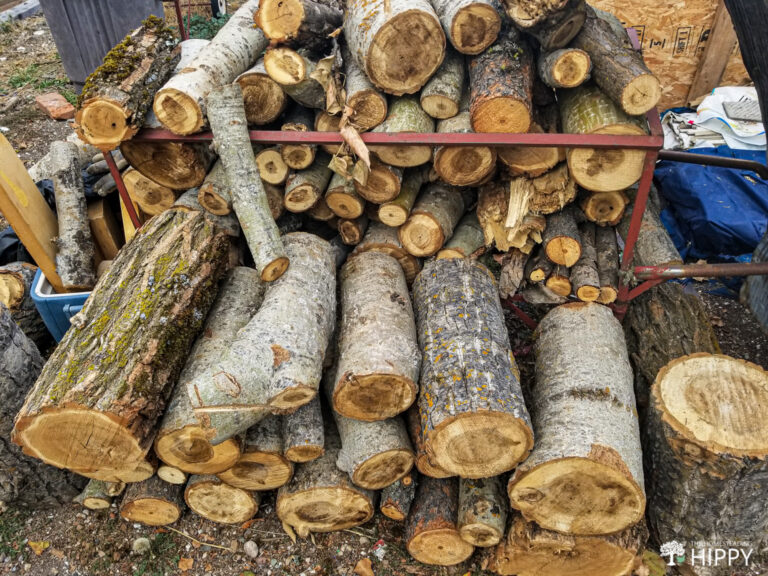
Log Splitter
If you’re not interested in splitting wood by hand then perhaps a log splitter is for you. These are great tools and can make your work go much quicker.
A log splitter functions by either driving the wood into a fixed wedge (basically a big ax blade) or driving a wedge into the wood as it is held in place.
Upon splitting, the pieces either fall off or must be retrieved before placing the next piece in the splitter.
Of course, there is an initial investment when you buy one of these but if you plan to heat with wood for any length of time then it may be worth the investment as it will save you time and effort in the long run.
There are several different types of log splitters on the market. You can find electric ones, gas-powered ones, and even manually powered ones that you operate by hand with a lever. The best type of log splitter for you will depend on your particular circumstances.
The capability of the splitter is directly proportional to its size and power. Larger splitters can hew through sizeable logs, while small splitters are only capable of handling typical pieces of firewood. For our purposes, the latter is all you’ll need…
We prefer electric as we don’t like spending on gas more than we have to and we have access to an outlet so we can plug it in. Do your research and figure out which one would best suit your needs before making a purchase.
Wet Wood Vs Dry Wood
Dry wood is far easier to split than wet or green wood. Dry wood will also burn cleaner and easier. Wet or green wood will leave creosote which is highly flammable in your chimney, woodstove or fireplace. As the old timers say, season for a season.
If you cut your firewood in the spring, it will have had plenty of time to season and be ready come fall.
Allowing your wood to season for a season will make your wood far easier to split, and far more efficient to burn. If you must split green wood, give it as long as possible to dry out so that you’re not having to work harder to split it.
Always Split Along or “With” the Grain of the Wood
Splitting wood is always hard work, but it can be a lot harder if you don’t understand the fundamentals of the task at hand.
One of the most important fundamentals is to always make sure that you’re splitting along or “with” the grain of the wood.
This may seem like a no-brainer, but you’d be surprised at how many people try to split (chop) wood against the grain.
While it is possible to do this and is sometimes necessary, it’s significantly more difficult and makes the task that much more strenuous, particularly when using an axe, hatchet or maul. A saw is best for this task if you must!
Additionally, trying to split wood against the grain can also be dangerous as it puts more stress on the tool, increases impact shock and further increases the risk of a deflection.
When swinging an axe or hatchet full strength, the worst thing that can happen is for the blade to glance off the wood and hit you instead. It might be the feet, with an axe, or it could be a disastrous hit to the shin or thigh with a hatchet.
Either outcome is terrible, and may prove fatal. Either is more likely to happen when chopping against the grain.
Always Use a Sharp Tool
This may seem like another no-brainer, but it’s important nonetheless. Always make sure that your axe, hatchet or maul is properly sharpened before starting any work. Dull blades make for dangerous work!
This is because it increases the risk of a glancing blow or kickback in the case of a chainsaw, and in all cases will mean you are working harder, longer, to do the same work. Take care of your tools and they will help take care of you.
If you’re not comfortable sharpening your own tools, there are plenty of places that will do it for you (for a price). Many hardware stores have tool-sharpening services available or you can take it to a professional if you’d like.
Kickback is when the piece of wood you’re splitting flies back toward you with a lot of force and can seriously injure you if you’re not prepared for it.
Wood Splitting Tips And Tricks
Try to avoid over striking when you’re using your splitting maul. Doing this repeatedly can result in a broken maul handle.
Stand farther back if you notice that you’re constantly over striking and missing your wood or barely clipping it with your splitting maul when you swing down.
There is a bit of controversy on whether or not to use a cutting or chopping block. We prefer to use one so that we aren’t hitting the dirt and dulling our ax blade. If you learned differently then don’t use one.
Wood should be split so that it will easily fit into your wood stove or fireplace. For some pieces you may have to repeat the splitting several times to have pieces that are the right size to fit into your wood stove or fireplace.
If you have a piece of wood that is “Y” shaped, aim for the shorter edge of the “Y” in the center of the branch to split it. It took us awhile to figure this out and it works, every time.
Harder woods and denser wood is going to give you more heat (BTU s) than softer woods.
Softer woods still give you heat so don’t think that you should only use hard woods in your wood stove or fireplace.
Oak will split easier when it’s green. Elm tends to split easier when it’s dry. As I said, it all depends on the particular type of wood so you may have to make a few different piles and split different woods before and after they season.
When stacking your wood, make sure that you leave room for air to circulate so that it can continue to dry out while you’re waiting to use it.
You don’t have to be big and burly to effectively split wood. It’s technique, not brawn. Always keep this in mind and let your ax and your splitting maul do the work for you.
Rambunctious teenage boys can split a lot of wood (which makes them excellent “athletes” and is an excellent workout, it’s also an ideal punishment if they’re being obnoxious.).
Keep toddlers and pets away when splitting wood, fragments and splinters can fly great distances and injure toddlers (eyes, skin etc.) and pets. Also, should the round decide to fly off it can become a projectile and injure a child or pet.
Again, pace yourself. On our homestead we only work on the wood about an hour each day. However, you may want to go for a few hours. It’s all up to you.
Just remember that spending an entire day splitting wood is very painful on your muscles the next day. Don’t overdo it. Be patient and take your time. It’s a process, not a race.
There are many different ways to split wood. Some prefer to do it differently. That’s fine. This is what works for us and our needs.
It’s important to keep in mind that while different people do it differently, it’s still vital to remember safety rules and follow them to ensure your safety, and that of your kids and pets, at all times.

Nice article BUT it depends on what type of wood how big the splits are and so on for drying time. There is just a few that will be dry enough to burn in one year after it is split and stacked. Soft maple, ash and pine will be ok to burn in one year but 2 would be better. Hedge is another one that is ok to go after one but 2-3 is a whole lot better. A lot depends on size of splits when it comes to hardwoods such as oak hickory and so on. I would never burn any hardwoods in less than 3 years on a average split , no way these will be ready in one year air dried. Average split to me is about a 3×4 triangle. I split all of mine about 5×6 and a little larger, a 8 inch round limb is split down the middle. Yes it takes longer to dry that is why I am 5 years ahead and as long it is stacked OFF the ground and top covered it will last for several years. Like your house keep it dry it will last for years too.
Thank you for the great tips. 🙂
Good Evening,
I enjoyed your article; do more,
Thanks, Terry
I was also taught to split a piece, from what would have been the top of the tree downward.
Thank You for this article. I admire everything you and your family do for yourselves in homesteading and for sharing to us. I’m sure there are others like me that wish they could homestead like you, I sure enjoyed this article because it reminded me so much of when I was growing up and working for all the farmers bailing hay, weeding bean fields, and cleaning hedge rows. And yes, like you said…splitting wood a little each day because there was always wood to split. ?